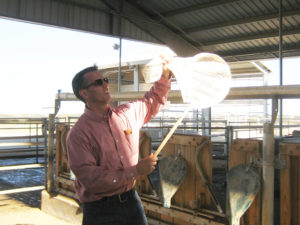The high quality of Associate Professor Dr. Jeffery Tomberlin’s work in finding out how to best determine the time of death of animals by using microbiological processes of fly attraction has helped him to be featured in the September 2015 issue of Microbiologist magazine.
The magazine is a publication of the professional organization called Society for Applied Microbiology and featured several articles on research in the microbiological field. The September issue featured the Tomberlin Lab and showed how he and his lab used microbiological processes in breaking down tissues to determine the time of death of an organism.
When an animal dies, he said that the microbes begin in the carcass begin to break down tissues, which produces gases and begins bloating the body over time. Flies used these odors to locate the remains and then lay their eggs or larvae in the moist cavities, such as the nose, mouth, or eyes. The offspring of these flies then feed on the soft tissues.
Different species of flies vary in their diet, and some flies, such as the black soldier fly are omnivorous, which means that they are able to eat a wide variety of foods. He then said that once the maggots eat their share, other insects including beetles, and scavenging animals would eat what is left of the animal.
Forensic entomologists, such as Tomberlin, study flies and maggots to determine what factors influence when insects start colonizing human or animal remains. He said that a better understanding of the colonization times would allow forensic scientists to help better predict the actual time of death of the person in question.
Tomberlin said that the unknown factor is what attracts certain insects to a decomposing body. He said researchers suspect that odors that are released by microbes as they break down certain substances may be a major factor.
“We are interested in determining how microbes communicate with one another and how these messages influence insect behavior- specifically with regards to insects attract to, and colonizing, human remains, Tomberlin said. “A better understanding of these interactions could result in precise methods for determining not only when someone is colonized by insects (a minimum time of death) but when they actually die.”
Tomberlin was excited to see his research featured in this article and said it was a great way to showcase the quality of research that his lab has been working on.
“I am thrilled to have a featured article published in The Microbiologist as it reaches microbiologists around the world,” he said. “Such articles together serve as the stage that we get to discuss the implications of microbiology and interkingdom communication as they relate to forensic research.”
The full article can be read at: http://issuu.com/societyforappliedmicrobiology/docs/microbiologistseptemberweb
